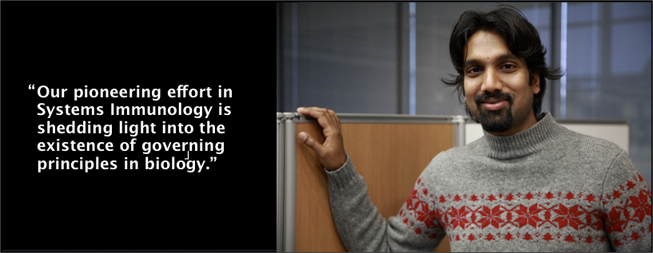HOME  論文/ハイライト
論文/ハイライト  研究ハイライト
研究ハイライト  研究者インタビュー
研究者インタビュー  Assistant Professor Kumar Selvarajoo
Assistant Professor Kumar Selvarajoo
11.02.09
Assistant Professor Kumar Selvarajoo
(11.02.09)


-- Tell us about your current research.
Since joining IAB in April 2006, I have been a co-leader of the Systems Immunology initiative (together with Dr Masa Tsuchiya).
Since molecular interactions within immune cells are inter-connected forming large-scale networks, the study of individual immunological molecule, one at a time, is not sufficient to infer system-level properties of immune response. On the other hand, despite the presence of thousands of different molecules within a cell, it is intriguing to observe deterministic cellular processes such as host-pathogen recognition or the differentiation of hematopoietic stem cells to immune cells. How such networks and processes occur? What guides them? To understand such elementary questions, our projects have been designed to recognize the existence of the law of nature in biology, and to tap them for the elucidation of fundamental behavior of the complex mammalian immune system. Our current results on Toll-like-Receptor (TLR), Tumour Necrosis Factor (TNF)- alpha, TNF-related apoptosis-inducing ligand (TRAIL) signal transduction, from receptor stimulation to the temporal expression of genes, have shown that the law of signaling flux conservation exists. Using this, we have identified novel properties of complex signaling networks, such as the reason for time delayed activation or enhanced activation of alternative pathways in mutant cells, and these results have been experimentally validated by colleagues from the Keio Medical School. So, unlike the popular believe that signal transduction is highly non-linear and complex, we have shown that their average response follow simple linear rules.
More recently, our large-scale gene expression studies have identified roles for ubiquitous lowly expressed genes, which are often discarded on the assumption that their expression readout is noisy and unreliable. We achieved our "unexpected" result by the observing that forming genes into groups, before analyzing them, eliminates noise following the inverse square root law (as often used in statistical physics). This led us to show biphasic behavior of whole genome in lipopolysaccaride-stimulate macrophages, i) a local proinflammatory response and ii) a global response consisting of diverse processes. A similar technique, when applied to immune cell differentiation (HL-60 to neutrophil) process, uncovered the fractal-like behavior of gene ensembles. The collective response of these specific ensembles guides neutrophil differentiation, revealing the presence of "genome vehicle" for cell differentiation. Overall, our pioneering effort in Systems Immunology is shedding light into the existence of governing principles in biology and we hope to continue this exciting research as an integrated team into the future.
-- How did you come to the immunology field?
I obtained a direct 4-year Master of Engineering degree in Aerospace from the Imperial College of Science, Technology and Medicine, London (1997). This basically built my fundamental understanding of numerous universal theories, concepts, computations and experimentations related to the aerospace sector.
After spending 3 years in engineering industries, I decided to embark on a PhD degree at the Nanyang Technological University in my home town Singapore. At that time in 2000, I was introduced to research activities at the National Cancer Centre, Singapore, for any joint research projects. After meeting several investigators, I felt that the systemic approaches used in physics and engineering fields can aid in the better understanding of complex biological and cancer processes. As first, decided on a project to understand the regulation of glycolysis in muscle cells and Trypanosoma brucei. I found the simplification into formation and depletion terms could be applied successfully to model the dynamic turnover of molecular concentrations of glycolytic metabolites to glucose perturbation. The novel methodology suggested that complex glycolysis regulation could be understood without the requirement of multitude of biochemical parameters which are difficult to obtain in vivo.
Part of my PhD methodology was published as a US patent application which resulted in the formation of a spin-off company, Systome Therapeutics in 2002. I was appointed as the Director of Technology of Systome Therapeutics and was involved in designing and managing the company to use computational methods to identify novel therapeutic targets by systemic interference with biological pathways. Basically, our business plan involved me to direct scientific staff to develop and use systems biology approaches for metabolic disease intervention.
In 2004, upon completion of my PhD, I was invited to join the Bioinformatics Institute (BII), Singapore as a project leader. At BII, my interest of understanding the regulation of molecular interaction spread towards practical application.
I led a small team that modeled the dynamics of i) lipid metabolic pathways in control (normal) and insulin resistance state and ii) the immune signaling response in wildtype and genetic knockouts, using computational approaches. Notably, using linear response approach, without the requirement to determine detailed in vivo parameters, I simulated the signal transduction pathway leading to gene expression of the Toll-like receptor (TLR) 4 stimulation and predicted the existence of novel intermediary steps along one branch of the TLR4 pathways. This prediction was subsequently substantiated to be true by the characterization of biological processes from experimental work (e.g. endocytosis of TLR4 before TRIF activation) from other renowned immunology groups. This result encouraged me to stay focus in immunology.
In 2005, I met Dr Masa Tsuchiya at BII, just as he moved in from the US, and we started to collaborate due to our common interest. We worked on the fundamental reasoning of why simple rules can operate in biology and developed the Non-Integral Connectivity Method, which is a more formalized approach to address the connectivity of biological networks and their response using the law of mass conservation. Our formulation was selected by the Agency for Science, Technology and Research (A*STAR), a lead government agency of Singapore dedicated to fostering world-class scientific research for a US patent application. This work also subsequently became available as a peer reviewed Imperial College journal publication and a book chapter for Humana Press on Systems Biology.
In 2006, I moved here to IAB with Dr Tsuchiya. Although we work in immunology, we are actually investigating the fundamental behaviors of biology.
-- What is the impression of IAB?
Several good things are surely apparent here, including excellent group of scientists, students, facilities, and Tomita-san's directorship. Sometimes directors tend to have control over the research projects or focus, but here we have much freedom with no major issue for research funding. On the other hand, I think the communication between faculty members and students can be a problem. I feel that generally students and staffs are too shy or are reluctant to communicate in English, restricting the circle within the Japanese speaking community. People like us who cannot speak fluent Japanese can become isolated because of this reluctance for English-based communication, and we are not able to feel the full pleasure of being a faculty member surrounded with students and staff collaborators. I think this situation needs to change. My mother tongue is not English, and I do not promote my own language. However, I love English language simply because it is a recognized international language.
-- Do you have something that you do everyday outside of work?
I like traveling, including driving, going to the mountains, lakes and exploring the nature. I love the four seasons and so photography has also become my major hobby.
Others include watching movies, reading news on the Internet especially on politics is also my hobby and passion. I am interested to know how the Japanese government can influence the political and economical situation internationally, for example, the regulation of the rising yen.
-- Did you come to Japan with your family?
Yes. I have my wife, Krisvene Kumar and two children, Lucas Kumar and Davisha Kumar.
Both my children attend local schools and are very fluent Japanese speakers.
-- What would you like to achieve in your future?
I am an ambitious person, and through research, I want to produce tangible things to the society. Since traditional biological approaches are unable to provide comprehensive understanding of dynamic living systems, I believe systems biology approaches are necessary to obtain a fuller picture. Deciphering the fundamental laws in biological systems, for example, will surely help us to identify key molecules, processes and unexpected behaviours, such as, Signaling Flux Redistribution, in proinflammatory disease and cancer. Uncovering these can produce a better shot for controlling diseases processes. Also, a more descriptive role for the lowly expressed genes and insight into the "genome vehicles" during cell differentiation will advance our knowledge especially for the differentiation and proliferation of malignant tissues. Gaining knowledge here, I hope to contribute towards holistic medicine to treat complex diseases.
Apart from science and medicine, I also have interest in politics, not so becoming a politician myself, but to become an adviser for some political decisions made in my country. Scientists are trained to think deeply, and I would like to use the resultant knowledge to change the decision making process of politicians, for the sake of the citizens to enjoy a better meaningful life. These are my dreams. Let's make it a reality!!
(Nov. 8th, 2007. Interviewer: Yukino Ogawa Editor: Taiko Nishino Photograph: Takeshi Masuda)



